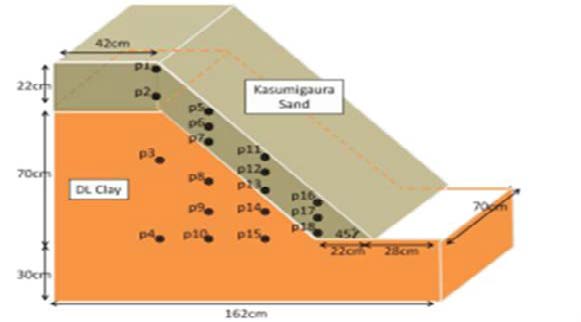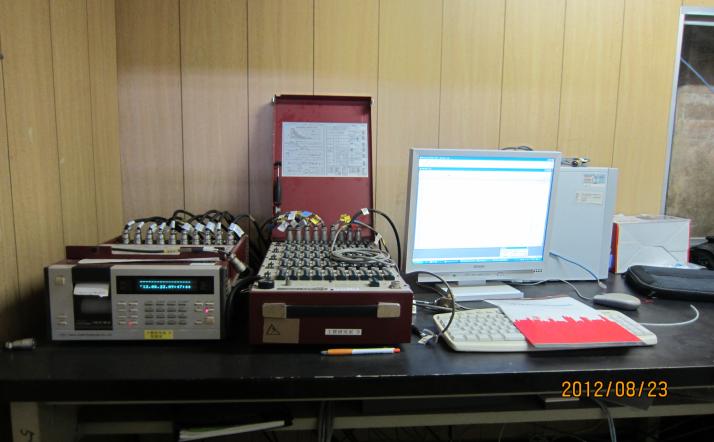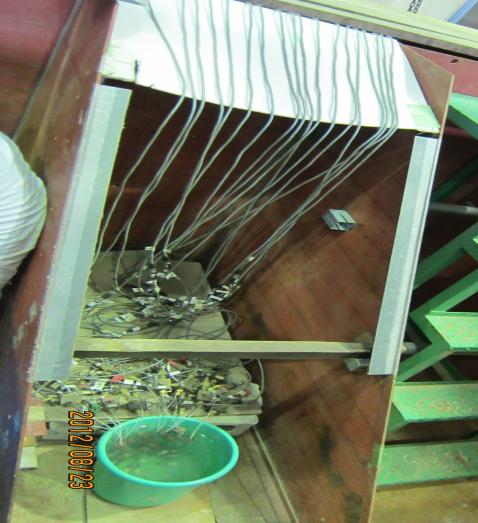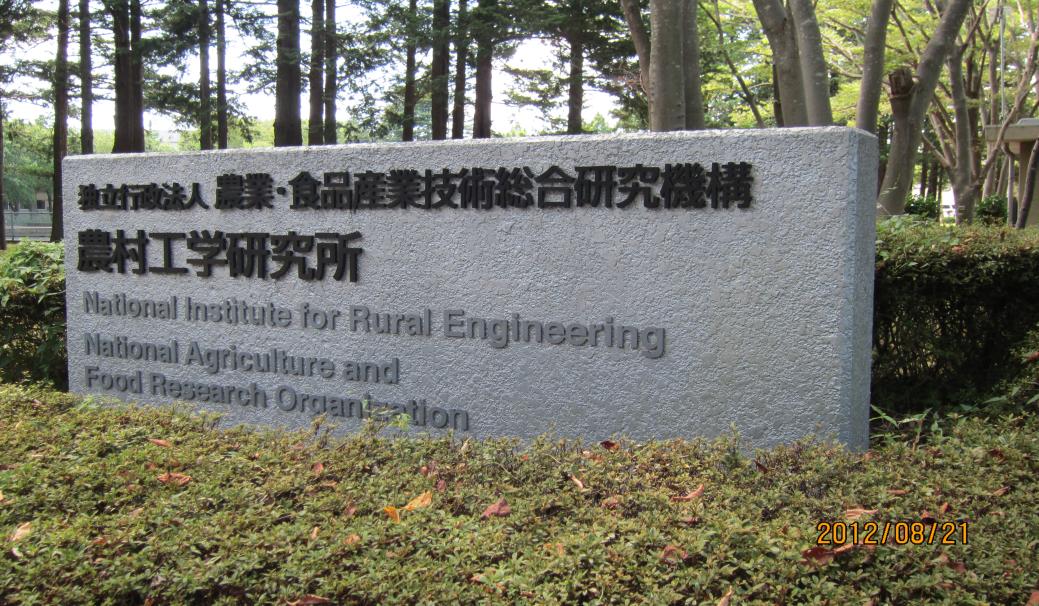活動報告
筑波・農業工学研究所/環境地質工学に関するモデルテストへの参画
Host:National Agriculture and Food Research Organization (NARO)
Location: Tsukuba (Japan)
Duration:August 16 to 24
Key words: Preparation of testing apparatus, Construction of slope and Rainfall intensity
Pyone Win Win ![]()
International Environmental and Agricultural Science Department
Tokyo University of Agriculture and Technology
(1) Activities during the internship
During my FOLENS internship program from August 16 through August 24, in Tsukuba Research Center, I was attached to National Agriculture and Food Research Organization (NARO). The mission of NARO is to focus mainly on the research and development of stable food supply systems, related global-scale issues, agricultural products and foods for new markets and future industries and rural resources.
I got a chance to become a member of NARO to study various environmental problem related research. Among many sectors of their research, I was assigned to observe the slope stability model test on the effect of rainfall intensity together with Head of the Soil Mechanics Laboratory Dr. Toshikazu Hori and other two members. Climate change due to global warming is one of the most concerned issues in the world. Recently, in case of Japan, we have not only larger-sized typhoons but also a lot of local heavy rainfalls with the global warming. A lot of natural or artificial slopes fail due to heavy rainfalls every year in Japan. Not only in Japan but also around the world slope failure problem is very common by the effect of heavy rainfall including my country (Myanmar). Therefore, it becomes more important to investigate the stability of slopes against rainfalls and to develop disaster protection planning.
For my internship, there are three steps I had to learn to complete one model test, such as the preparation and calibration of testing apparatus, construction of slope and rainfall intensity justifying and analysis of model test results. I was taught by Dr. Hori about the slope stability model test. The model slopes used in this test is shown in Figure 1. In this model tests, two materials were used: Kasumigaura-sand and DL clay to construct slope. We constructed the slope with Kasumigaura sand as the subsurface layer of the slope and DL clay as the hard foundation of the slope. The dimensions of slope model are 120cm in height, 42 cm in crest width, 70 cm in depth and 162 cm in base length. The slope gradient is 45 degrees. At first, base foundation was constructed by compacting DL clay in the maximum dry density. After that, sand layer was laid on the DL clay base. The density is D = 100% in DL clay and Dr = 0% in Kasumigaura sand. After completion of slope construction, we supplied the 50 mm/hr rainfall intensity until slope failure occurred.
During the tests, PWPs (Pore water pressures) were monitored with 18 PWPs transducers. Each transducer was set as shown in Fig.1. To measure the displacements of the slopes, pictures were taken from the side of the slope model using a digital camera. The displacements were calculated by using Particle Image Velocity (PIV) analysis method. Moreover Figure 2and 3 show the auto data logging system and related pore-water pressure transducers. From this model test, we can know the proper procedure of slope protection planning such as water management with suitable drainage system, earthwork comprising of cutting unstable portion of the slope, combination of water management and earthworks. The structure of the whole study is to clarify slope failure mechanism due to difference of conditions (rainfall intensity and subsurface density), model test were simulated using saturated-unsaturated consolidation analysis method with the same conditions and compare the results of practical and simulation.
 |
|
| Figure.1. Model slope configuration used in 1 G test | |
 |
 |
| ↑Figure 2. Auto data logging system Figure 3. Pore-water pressure transducer→ |
|
(2)Experience and achievements resulting from the internship
From this internship I got the opportunity to study a new technology and knowledge about environmental issues solution. I could see various kinds of experimental testing apparatus in NARO, especially for the soil mechanics field. I could observe one of the slope stability model tests and get information about the basic knowledge of slope construction. This experience was the very first time for me to learn about the model test. From these experiences and practices I learnt more about the artificial rainfall instrument which was used to conduct a rainfall model test. I could see the operating system of rainfall instrument. Furthermore, I got information about a digital camera using technique to measure the displacement of soil failure in the slope model. Two digital cameras were used in order to take pictures for calculating displacement. One is Power shot G3 (Canon Inc.), which was putted above the slope and the other one is EOS 30D (Canon Inc.), which was putted in the front of a soil box. Each digital camera was connected with a computer and took a picture by remote control in each position. This measurement technique is also very efficient to get the exact data of the slope deformation due to rainfall.
From our slope stability model test project, there were some interesting observations. My internship program lasted for 9 days so we could not even finish one model test. What I could operate for the slope model test was just the preparation to construct the slope and construction of the slope. Anyway there are many difficulties to do these things if our group had no good unity. But our group could get success because all of the group members were hardworking and eager to get better results. Moreover, our group got great communication with each other and improved language skills in English and Japanese. When we were trying to construct the slope working hard, we supported each other without any exception. It was one of the benefits of this internship program.
To know more information about the slope stability model test due to rainfall, I had read some literatures during my internship. According to literature and my practical works, it can be said that heavy rainfalls led to sediment disasters like slope failures and debris flows. Among victims of natural disasters, the number of victims of sediment disasters account for a considerable rate. Moreover, these sediment disasters have the potential to occur in various regions in Japan. The sediment related disasters are the most common natural hazard in Myanmar especially near the mountainous area. Sometime due to heavy rainfall slopes were failed and blocked to the road. Under these situations, it is necessary to consider and develop disaster planning that can reduce damages of sediment disasters. Combination of practical training and literature review allowed me for a greater understanding of the heavy rainfall impact on the slope stability. The practical work was very hard and time consuming but I was very interested and it provided me with the opportunity to study not only several new techniques, which can be applied in environmental and agricultural science, but also hints for my future research plan.
My internship program would not have been smooth without the support of my group member, Mr. Anusron Chueasamat; Mr. Shinde; and my supervisor in NARO (Head of the Soil Mechanics Laboratory) Dr. Toshikazu Hori; my supervisor in TUAT professor Dr. Yuji Kohgo and all of the FOLENS teachers and staff. This valuable internship provided me good experience and communication with other members, which are very important things for a community- and field-oriented leader in the environmental sector to get good leadership practices.
(3) Relationship between the internship experience and future career development as a field-oriented leader in Asia and Africa
The experience I got from this internship was one of the most meaningful and precious experiences for my life and for my present job as an Assistant Supervisor at Myanmar Agriculture Service, Ministry of Agriculture and Irrigation Department, Myanmar. Moreover, I gained valuable knowledge, skills and experience that will help me to become a leader in the environmental sector. I learned several perspectives on the impact of heavy rainfall and climate change on natural resources and natural disaster. Actually this topic which I learnt from internship is not directly related to my present job. However, during my internship, I got the personal experiences and good communication with other colleagues. This point is very important for my present job because I have to make good communication to share and transfer information on new agricultural technology and environmental issues to Myanmar farmers. In my country farmers and technician communication (friendship) is very important. Before we transfer our technology to farmers, we should have good friendship. If we can build good communication in one village, all of the farmers will accept our guidance about introduction of new technology, disaster protection methods and lecture to farmers about the important of climate change and relate environmental issues. So I will be able to extend the knowledge and ideas from this internship to Myanmar farmers especially about the climate change and natural disaster relationship and how they can maintain the natural resources without harmful impact to the environment.
Moreover, I will extend the invaluable experiences and skills from this internship not only to farmers but also my colleagues. I will encourage all of them to take care about the environmental issues and the conservation of natural resources more than before. My country is a developing country so most of the farmers and other citizens are not so rich with the knowledge of the environment rehabilitation and conservation practices. Therefore I will try to educate new generations to become good environmentalists in the future. Based on this internship experiences, I will also try to improve my own environmental knowledge and ability. After studying in Japan, when I return to my country, I would like to set up a group of environmental and agricultural awareness and technology extension for maintaining the good environmental condition, together with my colleagues and some interested farmers based on the knowledge and experiences I gained in this internship program.
 |
| Figure 4. My Internship place in Tsukuba (Japan) |